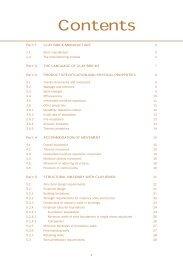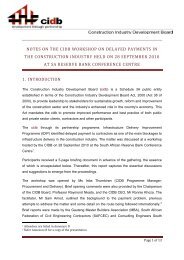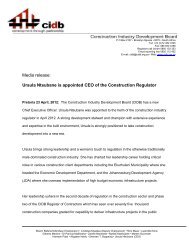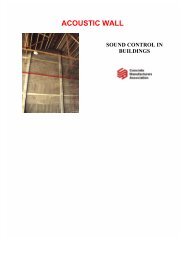MANUAL 4 - Construction Industry Development Board
MANUAL 4 - Construction Industry Development Board
MANUAL 4 - Construction Industry Development Board
You also want an ePaper? Increase the reach of your titles
YUMPU automatically turns print PDFs into web optimized ePapers that Google loves.
MODULE<br />
1<br />
2<br />
3<br />
4<br />
5<br />
6<br />
7<br />
<strong>MANUAL</strong> 4 – BITUMINOUS PAVEMENT SEALS<br />
4. <strong>Construction</strong><br />
4.1 Preparation of the base<br />
Preparation of the unstabilised base<br />
All loose dust or debris must be broomed off the surface and inspected for false layers which<br />
must also be removed for rectification after priming.<br />
• Establish the centre line of pavement and mark out the edges of the surface to be<br />
primed with sisal twine, 200 mm wider than width of final surfacing.<br />
• Place 2 3 210 litre drums of water and 2 3 210 litre drums of inverted emulsion prime<br />
at suitable distances along the road.<br />
• Using the motorised hand sprayer, spray a 210 litre drum of water uniformly over<br />
the surface of the base at approximately 0,5 litres/m 2 . (The 210 litre drum will cover<br />
± 400 m 2 or ± 100 m of 3,5 m wide road). .<br />
• Allow the water to soak in and when the surface is damp, apply the prime (inverted<br />
emulsion prime). (See note)<br />
• If the ambient temperature is > 20°C, it is not necessary to heat the prime.<br />
• Apply the prime at approximately 0,7 litres/m². If over applied, the prime will run. It is<br />
difficult to over apply as 0,7 litre/m² is the approximate top limit. If the gradients are<br />
steep, the prime may run at 0,5 to 0,6 litres/m².<br />
• Ensure that the spray screens are methodically used to prevent over spraying of the<br />
shoulders and ensure neat edge lines are achieved.<br />
Note<br />
Do not wet the surface using more than a drum of water at a time. This can be alternated<br />
with a drum of prime. The amount of prime sprayed/day will depend on the square<br />
metres of base completed per day.<br />
4.1.2 Preparation of stabilised bases<br />
• Emulsion-treated bases (ETB) can be opened to light traffic (< 500 vpd) for extended<br />
periods (one to two months), without special treatment. However, before surfacing,<br />
the road must be swept clean and apply diluted emulsion (60% stable grade Anionic),<br />
i.e. one part emulsion: 6 parts water, at a rate of 0,6 litres/m².<br />
• Lime stabilised bases must be allowed to dry out and then treated and primed as for<br />
unstabilised base.<br />
4.2 Spraying of binder<br />
Controls prior to spraying<br />
• Set out centre line and edge lines of the road with 3 mm sisal twine.<br />
• Place reinforced paper at start and end of spray joints.<br />
• Ensure that the supplier of binder has fixed fish plates at ends of spray bar fitted to the<br />
tanker.<br />
• Ensure that end-nozzles are fitted to spray bar.<br />
IMPLEMENTING EMPLOYMENT INTENSIVE ROAD WORKS 76












